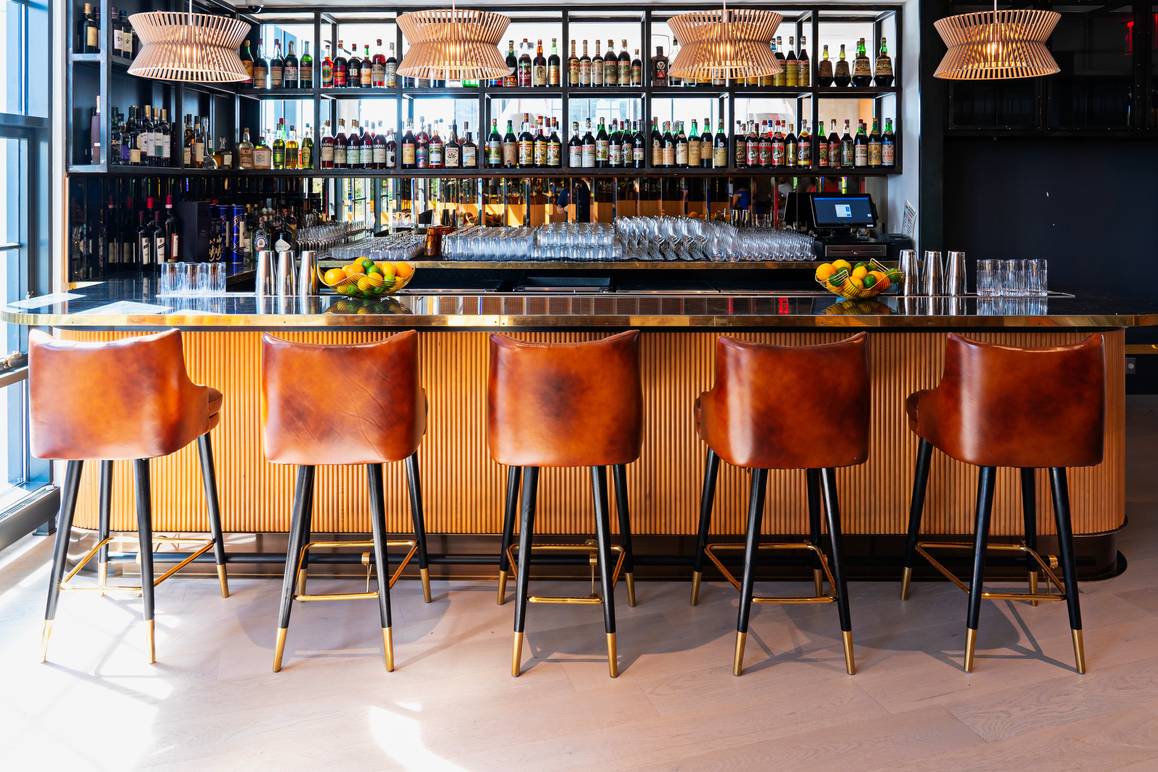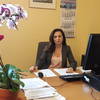Officina. The Evolution is Happening Every Day
The tall, dark-tinted windows of Officina on a cloudy day do not reveal what is held within the massive three-story building on Washington, DC’s The Wharf. Gray walls of stone and an unassuming exterior suggest that Officina is its English translation – a “workshop.” This title isn’t wrong. Inside, waiters are rubbing down glasses and countertops, butchers are slicing prosciutto, cooks are shaping delicate ravioli, bartenders are mixing amaro cocktails, and barristas are brewing rich Italian coffee.
A One-Stop Italian Shop
At the center of all this activity is Nick Stefanelli, a Michelin-starred chef who had a vision of creating a one-stop Italian shop. And a café. And a bar. And a trattoria. Officina offers all of these things to its guests.
The first level is big and open, with the sun streaming in through the tall windows and onto the glasses and bottles behind the counter of the café bar. Large, comfortable barstool chairs of navy blue line the pristine marble countertops, and intimate booths wrap around the wall. Freshly baked cornetti and crisp sfogliatelle are on display in the morning, and thick Roman pizza appears around noon. Later in the afternoon and evening, the coffee and espresso cups give way to slim wine and cocktail glasses.
Slightly below and directly serving the café area is an Italian market and butcher shop. Full cuts of beef, lamb, and pork hang behind glass, and slices of salumi are presented for sale or used in the panini going to the café bar. Stefanelli sources his meat from a small collection of farmers in West Virginia. The lamb comes from a nearby co-op, and the beef comes from the local Rosetta Farm.
Specialty cheeses imported from Italy are showcased in the luminous display counter. Jars of potted foie gras, artichokes, mushrooms, peperoncini, olives, and olive oil fill up the surrounding shelves. The smell of freshly baked bread is refreshingly different from the surrounding grocery store chains in DC. Linguine, chestnut tortellini, bucatini, and paccheri, handmade by Officina sit plentifully in wooden boxes and copper trays, ready for what Nick Stefanelli calls the “weekend chef” to bring home. And there is, of course, an ample selection of Italian wine.
Stefanelli drew from memories of childhood visits to small Italian stores and family-owned delis in Baltimore to build the market in Officina. Following the announcement of its opening on DC’s The Wharf, Italian Americans in the community put in requests for items they wanted to see included that they couldn’t find anywhere else nearby, like Mulino Bianco cookies. In this way, Officina is, according to Stefanelli, “filling a gap in DC by providing a market for people who want to cook authentic Italian food at home.”
Quality, Versatility, and Transparency
For Stefanelli, the most important aspect of the market is transparency. As guests work their way up from the café and market area on the winding grand staircase to the trattoria, “they see exactly where the ingredients in their dishes come from.” Stefanelli developed an appreciation for transparency and sourcing locally when he joined Roberto Donna at his Italian restaurant Galileo in Washington, DC.
“With Roberto, we were always buying from local farms. It wasn’t to follow a trend, it was just the style we were taught to cook in,” Stefanelli said of the James Beard Award-winning chef. Born in the Piedmont region of Italy, Donna is committed to promoting authentic Italian food and flavors in the United States. A large part of that is using high quality, locally-sourced ingredients and meat, tending to a garden in or near the restaurant, and producing items within the restaurant itself. This is the way it is done in Italy, and chefs like Roberto Donna have molded younger chefs like Stefanelli to use this style in America.
The flow of the market to the café to the trattoria not only induces transparency, it creates an all-day center for meeting with family and friends over flavorful, warm Italian food, wine, and cocktails. Officina becomes the Italian piazza, with the first floor as the early morning espresso and cornetto, followed by evening aperitivi. As guests climb the staircase under the yellow light of the modern chandelier, they spend the remaining hours of daylight in the trattoria overlooking the glittering Washington Channel and Potomac River. After dinner, the final stop of the night is the cozy, five-seat amaro bar and the terrazza’s seasonal cocktails with an exceptional rooftop view of Washington, DC. Each floor is a different time of day in the piazza.
Originally, Officina was meant to be only a market, with a few tables and chairs on the sidewalk. “We were already baking our own bread in Masseria, and making fresh pasta. I wanted to have a place where people could take that home to make it themselves,” Stefanelli began as he shared the story of Officina.
“When we looked at the compartmentalized layout of this building, all the pieces came together naturally. And I fell in love with the rooftop,” he added.
“Each individual person sees it and experiences it differently. People come in from The Wharf, buy bread in the market, and go home. Others come in with their girlfriends for a drink at the café bar. Everyone takes a different piece of it.” Stefanelli gestured to a family with two young boys running around the lobby, as their parents guided them to the café counter.
“This family will come in at half past eleven on a Saturday morning for coffee and arancini, but Tuesday night at eight the parents could come back for a celebration dinner with friends.”
Getting Ready For Summer
Officina only just opened in October 2018, and the staff has not seen a crowded Spring or Summer season on The Wharf yet. Aperitivi and dinner on the rooftop of the restaurant are sure to be the first stop before summer concerts at the nearby venue The Anthem. Although the coming season is daunting for the new restaurant, Stefanelli is excited to see the growth that will take place over the next couple of months.
“It takes a while for things to settle. A new restaurant is like a newborn baby. At first, you are still trying to figure out what your arms and legs are. But I’m excited to watch it mature into what it is going to be. We just opened, so we are still flexible to change what we want to. This space should turn into something that lasts for the next twenty-five years, but it will change and evolve over time. There was an explosion of people when we first opened, but this summer there will be a new explosion as people start figuring out what we are trying to do,” Stefanelli predicted.
In addition to Officina, Stefanelli owns the Michelin-star Italian restaurant Masseria, a favorite of high-profile people like Michelle Obama. Located in Washington, DC as well, Masseria showcases refined Italian cooking through tasting menus that delicately capture the unique coastal culture of Puglia, the region of Italy where Stefanelli’s family immigrated from. Officina will complement Masseria by introducing a wider audience of DC residents and tourists to region-specific cuisines of Italy.
“Food is a major social and familial focal point in Italy. Italian gastronomy ranges from simple pastas to luxurious ingredients like truffles, but all taste great. The menu in the trattoria brings out the simple and luxurious things from different regions across Italy, particularly Emilia-Romagna, which is just so rich with pasta dishes and wine. I like to drive and get lost in Italy, and discover things that way. My goal for Officina is to refine the classics, but maintain the heart and soul of it. I want people to come here for a great bowl of pasta and a great glass of wine, the simple things,” Stefanelli explained.
“The way we look at the dishes is different. We aren’t trying to be ‘right’ or ‘wrong’ in how we make Italian food.
Wine and Amaro
Another distinctive cornerstone of Officina is the impressive and alluring walls of wine that fold around the grand staircase in the center of the building. Stefanelli’s major focus is wine, and he has collected 4,900 bottles from all over Italy to serve in his restaurants.
“I collect the wine so that I am able to tell the stories. On Saturdays, we have wine tastings in the market,” so guests can learn “the story of wine and what wine is,” especially to Italians.
Italy’s Ministry of Agriculture and Forestry has documented over 350 grape varieties, which explains why there are so many stories Stefanelli and his staff can share with guests of Officina.
Roberto Donna was also a major influence on Stefanelli when it came to wine. Being from Piedmont, he introduced Stefanelli to the Barolos that were coming out of that region in the 1990s.
When Stefanelli went to work for Fabio Trabocchi at his restaurant Maestro, Vincent Feraud was the sommelier. From a spacious wine cellar crowded with over 800 wines from Italy, France, and the United States, Feraud would pull out a bottle for Stefanelli to try: “He would just hand me a glass of wine and say here, try this.”
He developed “likes and dislikes,” and a taste for high-quality, well-made wine. This informal education continued under the wine director at Bibiana, Francesco “Ciccio” Amodeo. Amodeo is from the picturesque Amalfi Coast, where he began his work in the hospitality industry in the small town of Furore. The majority of his family members served as winemakers and artisanal liqueur purveyors in the area, and he brought this training, history, and wealth of family knowledge to Washington, DC. Stefanelli discovered the many sweet and savory flavors of "rosolio" and "amaro" through working with Amodeo at Bibiana.
Now President and Master Distiller of Don Ciccio & Figli, an Italian herbal liqueur distillery in Washington, DC, Amodeo “opened [Stefanelli’s] eyes to the South of Italy when Sicily was gaining notoriety” for its wine.
“I’m still delving into the diversity of Southern Italian wine. There is exciting stuff coming out of Sicily and Sardinia. It’s an expensive habit,” laughed Stefanelli.
“I go to wineries in Italy to learn the philosophy behind their winemaking, learn why they came into it. Food and wine pairings, and why they go together, are interesting to me. At Masseria, everyone goes through pairing class and training, so they understand and can explain why certain wine and food go together. Once Officina is settled, we will do a cheese, salumi, and wine pairing class series for kitchen staff here. I want to open their eyes up to this world, too.”
The café bar will transform into a place where guests come to learn about wine, cheese, and salumi pairings, layering on another educational piece to Officina. Guests can even purchase the wine, cheeses, and salumi to take home and enjoy.
Like Francesco Amodeo, Stefanelli sees amaro as another way to explore the history of Italian gastronomy. Although not quite as big as the wine library, the amaro selection at Officina is also substantial.
“You see amaro everywhere now, but it has always been there, in Italy. There are more people inquisitive about it in Officina now. At first, we only had a couple of bottles of amaro that were less bitter, but people’s flavor profiles have surprised me. The bitter amaro has actually been popular. A lot of people will ask questions about it and want to understand,” Stefanelli said.
Stefanelli's Other Heritage
The next step in advancing his Italian heritage and cuisine in the United States consists in exploring the other, often overlooked side of his heritage, because of his Italian last name. He hopes to revolutionize Greek food in America by preparing it in a regionally specific way.
“My Italian family is from Puglia, which was at one point a part of Greece. I expect there to be cultural bleeding between Italian and Greek food. There are great people who have told the Italian food story in the United States. Just think about how Italian food was perceived in the 1960s compared to now.” Stefanelli conjures up images of simple, bland spaghetti and meatballs.
“I want to tell a new story of Greek food in the United States.”
As for Officina, guests can expect nothing but improved knowledge of wine pairings from staff, and even more fresh products made in-house to become available in the market. For Stefanelli, the evolution is happening every day. The overall warmth, color, the vibrant energy of the staff, and joyful voices echoing through the floors have made Officina a Mediterranean haven throughout the snowy DC winter. Sunset over the Southwest waterfront with Stefanelli’s authentic collection of wine, aperitivi, and simply genuine Italian plates is sure to be a rare taste of an Italian summer for residents and tourists in Washington, DC over the coming months.














































i-Italy
Facebook
Google+
This work may not be reproduced, in whole or in part, without prior written permission.
Questo lavoro non può essere riprodotto, in tutto o in parte, senza permesso scritto.